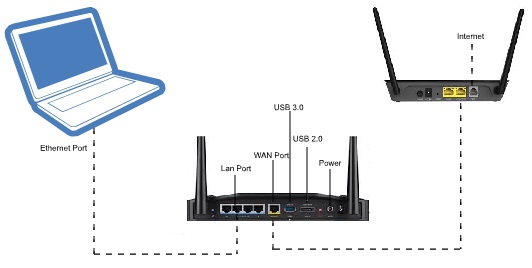What is router: Router is a network layer (Layer 3) of the OSI reference model device that means it can connect multiple computer networks via wired or wireless connections. Network router can receive, analyze, perform the traffic directing functions and forwards data packet from one network to its destination node. A router is a device that forwards packets between networks by processing the routing information included in the packet.
Routers use logical and physical addressing to connect two or more logically separate networks. They accomplish this connection by organizing the large network into logical network segments or sub-networks. Each of these sub networks is given a logical address. This allows the networks to be separate but still access each other and exchange data when necessary. Data is grouped into packets, or blocks of data. Each packet, in addition to having a physical device address, has a logical network address.
Network Router containing a software that help in determining the best path out of the available paths, for a particular transmission. They consist of a combination of hardware and software. The hardware includes the physical interfaces to the various networks in the internet work. The two main pieces of software in a router are the operating system and the routing protocol.
Routers are frequently used to interconnect identical networks as well as to interconnect networks with different types of hardware. Compared to one giant LAN, a series of smaller LANs connected through routers has some highly desirable benefits.

We’ll be covering the following topics in this tutorial:
Difference between Modem and Router
The Major difference between modem vs router is that, Modem is a Inter-networking device, while Router is a Networking device. Modem is working on Data link layer (Layer 2) of OSI reference model, on the other side router is working on Network Layer (Layer 3 devices). Modem can connect only one device,While Router can connect multiple devices.Modem can be used to connect home PCs to the Internet.Router can share (or “routes”) information between computer networks.
Benefits of Router
- Security: LANs operate in a broadcast mode. Information retrieved or transmitted goes on to the network and traverses the entire cable system. Only the station specifically addressed actually reads the data, but the data is physically presented to each station.
- Reliabilit:. If one network goes down because the server has stopped functioning or because of a fault in the cable, other networks and departments served by routers are not affected. The internet ting routers isolate the affected network, hence the unaffected networks although connected, experience no work stoppage or data loss.
- Performance enhancement within the individual network. Suppose that a network has 12 workstations, each of which generates approximately the same amount of traffic. In a single-network environment, all the traffic for those 12 workstations goes on the same cable. But if the network is split into 2 networks of 6 workstations each, the traffic load is cut to half. Each network has its own server and hard disk and is largely self-contained; so fewer PCs make demands on the network cabling system.
- Networking Range: In some networks, for instance, cable length cannot exceed 1,000 meters. A router effectively nullifies this limitation by performing the function of a repeater and reconstituting the signal. Physical range can be whatever is required by the particular installation, provided that a router is installed before the maximum cable range is exceeded.
Types of Routers
Many kinds of Routers are present in the current market that are depending on the need of the any enterprises. Cisco is the major manufacturer of router mostly Cisco router are used to set up network of large corporation and even of the ISPs. Broadly Routers are divided into three categories that depending upon the corporate needs.
Internet Connectivity Routers
These routers are used in Border Gateway Protocol for exchange information. These type of routers are further divided into four more categories.
Edge router
A Edge router or Network egde devices (It refer to host systems, which can host applications like web browser.) is routes data packets between LANs and an Asynchronous Transfer Mode (ATM) network.
Subscriber edge router (SER)
Subscriber edge router (SER) Also known as Customer Edge router.Customer Edge router use EBGP protocol, it used in (enterprise) organization.
Inter provider border router
Inter provider border router are used for Interconnecting ISPs. Inter provider border router use BGP protocol to speake.
Core router
When a router become the integral part of the LAN(Local Area Network) is called core router. Core router uses internal BGP protocol.Core routers have specialized functions in VPN,that is based on a combination of BGP and Multi-Protocol Label Switching protocols.
One Another Type of Router is SOHO routers. It is used for connection other networks in small geographical area it is known as SOHO connectivity.
How Router Work
Router contain a CPU, digital memory, and input-output (I/O) interfaces, that is used to transfer the datum packets along networks by visualizing the networks path. Routers visualizing the networks path to many networks such as Electronic networks, Transport networks and phone networks.
Two ways are exist for routers operation using either control plane or forwarding plane.
In control plane the router sends the precise data packets to their specific location. On the other hand in forwarding plane router does not remember the sending or receiving information about the packets.
Advantages of Router
Router route the data in an organized way. Router generate a reliable connection between hosts. Router is used for alternatively incase the main is fail to transfer data.
 Dinesh Thakur holds an B.C.A, MCDBA, MCSD certifications. Dinesh authors the hugely popular
Dinesh Thakur holds an B.C.A, MCDBA, MCSD certifications. Dinesh authors the hugely popular